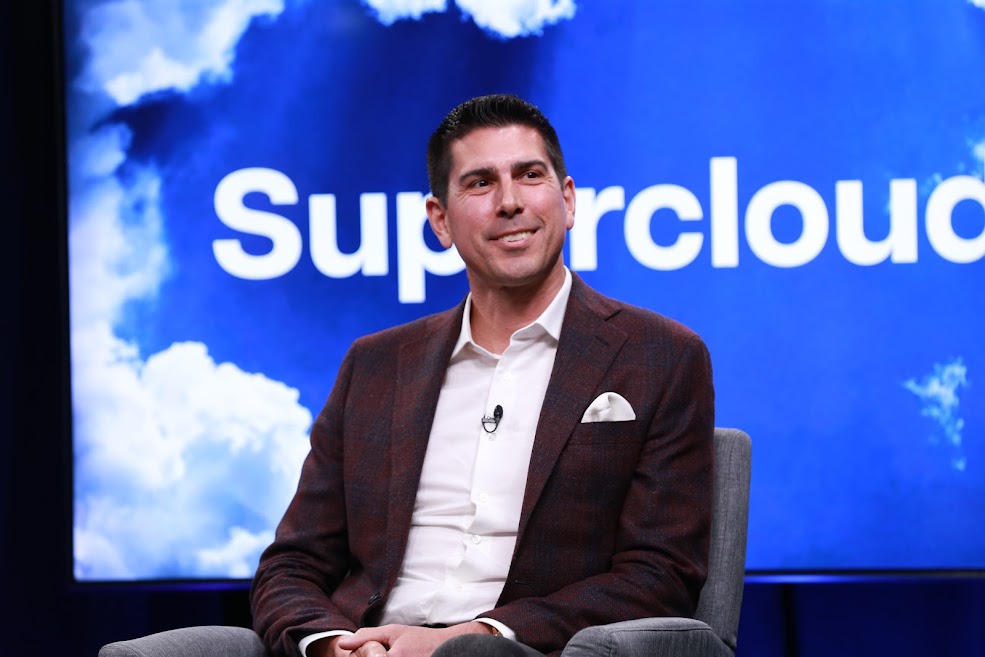 CLOUD
CLOUD
 CLOUD
CLOUD
 CLOUD
CLOUD
VMware Inc. recently took the multicloud concepts embedded in its Cross-Cloud services offering and distilled them into a white paper.
The firm’s work represented a first-cut proposal that the technology industry should engage in a conversation around the need for standardized multicloud services. That dialogue has evolved into further discussion on the VMware website about the supercloud, led by the company’s chief technology officer, Kit Colbert (pictured). On Tuesday, Colbert joined theCUBE, SiliconANGLE Media’s livestreaming studio, to further outline his thinking behind the dawn of the multicloud services era.
“Where you want to get to is a common service with a common operational team behind it that is trained and can work across clouds,” Colbert said. “It’s about moving away from these single cloud services that just solve a problem for one cloud to something we call a cross-cloud service, something that can support a set of functionalities across all clouds. When you evolve that across the board, you get this sort of supercloud. That’s really the important evolution here.”
Colbert spoke with theCUBE industry analysts Dave Vellante and John Furrier at the Supercloud2 event, during an exclusive broadcast on theCUBE. They discussed key trends driving the need for multicloud services and VMware’s vision for new architectures in the cloud. (* Disclosure below.)
What is powering the current conversation around multicloud services and supercloud is a growing problem for IT customers. Businesses are selecting multiple clouds to run specific services tailored for a particular cloud platform, but this builds data silos and creates a significant management headache.
“The journey we see customers on today is going from cloud first into this phase that many customers are stuck in called Cloud Chaos,” Colbert said. “They have to replicate that stack they’ve built for each different cloud, and they do this in a siloed manner. Where they want to get to is cloud smart, how to use the cloud more effectively, more intelligently.”
A more intelligent approach involves defining an architecture that can deliver the right kind of consistency and optionality across multiple cloud platforms. For Colbert, security offers a prime example for why this is necessary.
“A secure software supply chain is probably one of the top ones that I hear when I talk to customers,” he said. “Typically, teams have gone off and created individual secure software supply chain solutions for each cloud. I want a single security solution that works across all clouds.”
This desire for a single cross-platform solution highlights an evolution in the enterprise view of cloud infrastructure. As the cloud has become a larger presence in organizational IT, it is seen both as a resource for specific functions and as the provider of a broad set of common services that are needed throughout.
“Do you need a database or AI or machine learning systems for your application?” Colbert asked. “That’s going to drive your choice of the cloud. But there are things not necessarily highly differentiated yet they are absolutely critical to creating a successful application. Those are things that you want to standardize.”
Reaching this level of standardization will take cooperation by major players in the technology world, according to Colbert. VMware has taken its own step with the creation of a Cross-Cloud services portfolio encompassing application development, cloud management, security and networking. However, the company does not view multicloud services as an opportunity for business domination.
“One of the opportunities with supercloud is there is no single vendor that can solve all of these problems,” Colbert said. “It’s got to be the industry coming together as a community, interoperating and working together. I think about it as an architecture where there’s got to be these well-defined categories of functionality to enable businesses to pick and choose the right sorts of services and weave those together into a supercloud.”
VMware views the current supercloud discussion as a starting point, an opportunity for a larger dialogue around what multicloud services should look like and how they will be defined.
“The way services have been packaged together by the hyperscalers is now being challenged,” Colbert said. “What we’re seeing is the next phase of cloud, opening that up to new levels of innovation. That will be huge for businesses, because it will meet them where they are instead of needing to contort the business to make it work with the technology.”
Here’s the complete video interview, part of SiliconANGLE’s and theCUBE’s coverage of Supercloud2:
(* Disclosure: VMware sponsored this segment of theCUBE. Neither VMware nor other sponsors have editorial control over content on theCUBE or SiliconANGLE.)
Support our mission to keep content open and free by engaging with theCUBE community. Join theCUBE’s Alumni Trust Network, where technology leaders connect, share intelligence and create opportunities.
Founded by tech visionaries John Furrier and Dave Vellante, SiliconANGLE Media has built a dynamic ecosystem of industry-leading digital media brands that reach 15+ million elite tech professionals. Our new proprietary theCUBE AI Video Cloud is breaking ground in audience interaction, leveraging theCUBEai.com neural network to help technology companies make data-driven decisions and stay at the forefront of industry conversations.